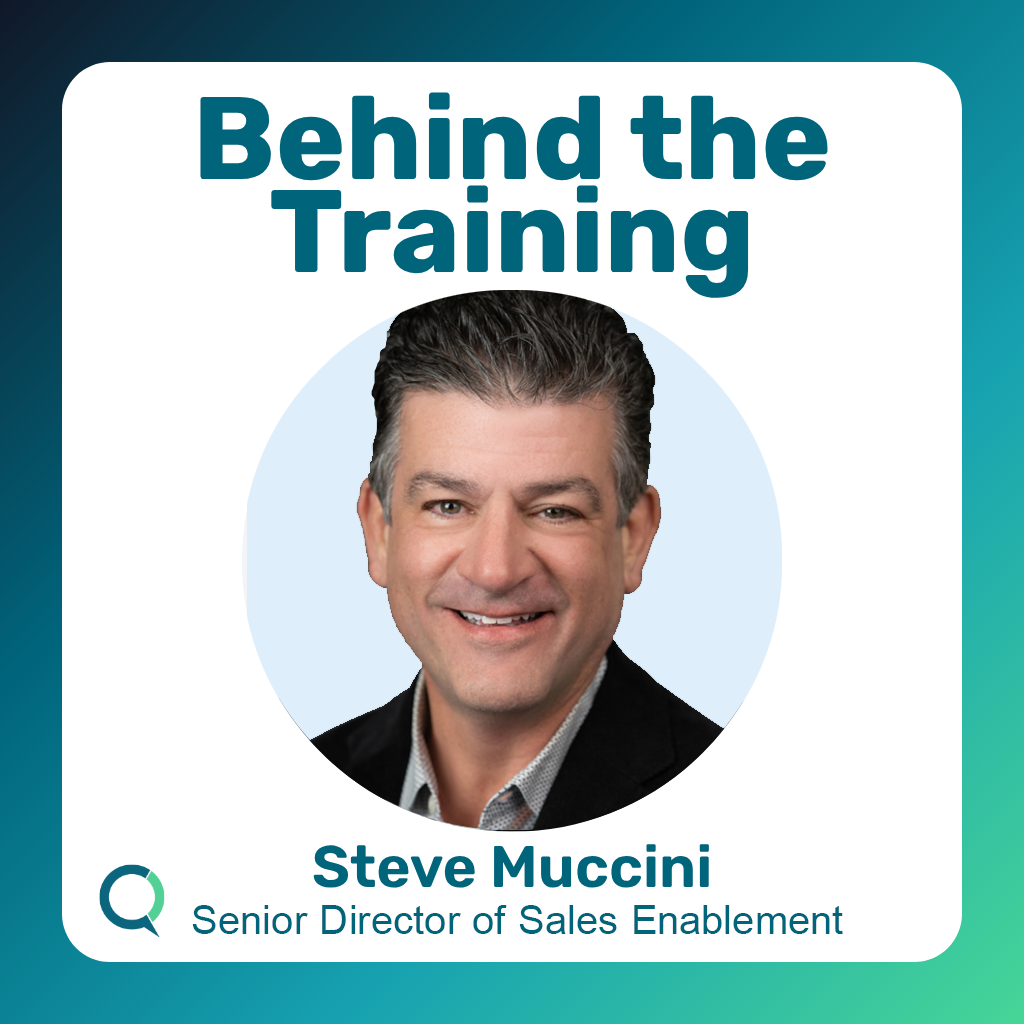In this episode of Behind the Training, we talk with Steve Muccini, Senior Director of Sales Enablement, whose journey blends marketing, sales, and a systems-minded approach to enablement. Steve shares how his early career in marketing shaped his thinking—and why he now sees enablement as less about training individuals and more about enabling the process.
Listen on Spotify or Apple Podcasts, or check out the video and summary below.
Q: Steve, you’ve been in both marketing and sales roles – what brought you into enablement?
I started in marketing with the goal of becoming a VP, but one of my first jobs was actually in sales—selling ad space to companies like Microsoft and Borland. That’s where I caught the energy of the deal. I moved back into marketing and product roles, but I always felt too far from the actual sales process. I was creating materials, but I didn’t know how deals were really being closed. That disconnect drove me toward enablement—because I wanted to be part of the outcome, not just the input.
Q: You’ve described yourself more as a “GTM architect” than a trainer. Why?
Enablement often gets lumped in as a service function—train the reps, check the box. But real enablement is about connecting systems: aligning marketing, sales, and product so the whole GTM motion runs smoother. I see my role as making that system work—designing the process, not just supporting the people.
Q: You once said, “It’s not about enabling the people—it’s about enabling the process.” What do you mean by that?
People are obviously critical, but they’re not scalable the same way a well-designed process is. If you build a consistent, flexible process—one grounded in a shared language like MEDDIC or Command of the Message—then coaching, onboarding, and selling all get easier. Without that, coaching becomes ad hoc and reactive. With a clear process, you can coach at scale, onboard faster, and actually measure impact.
Q: You’re T3 certified in Command of the Message and also MEDDIC-certified. How do those frameworks influence your approach?
They provide structure and language. Command of the Message, in particular, forces you to pause and define who your personas are, what differentiates you, and how to articulate value. That clarity helps reps and managers speak the same language. It’s not just about picking a methodology—it’s about making sure the whole team aligns around how we sell and who we’re selling to.
Q: You’re also known for your use of AI in enablement. Tell me about a few real examples of how you’re using AI in your day-to-day work.
The biggest impact so far has been on RFPs. I built an internal Copilot using Microsoft’s platform that pulls from past responses and internal docs. Reps can paste in an RFP and get a strong first draft in seconds—cutting time in half and improving consistency. I also used AI to analyze closed-won deals and reverse-engineer common buyer titles, which we now use to run more precise ZoomInfo queries. It’s AI doing the dishes so the team can focus on more strategic work.
Q: That’s a great way to put it—doing the dishes. What’s your philosophy on AI enablement tools in general?
Don’t just throw tools at the team. Vet them. Test them. Build workflows that make sense. Every vendor is bolting AI onto their product, but not every feature actually helps. As an enablement leader, part of my job is curating the tech stack—figuring out what works, what doesn’t, and how it all fits together into a daily workflow.
Q: Let’s talk onboarding. If you had to stand up an onboarding program from scratch, what are your non-negotiables?
First, you need a dedicated platform to manage the content and track progress. Second, build custom content that reflects how your business actually works. Don’t just rely on vendor training. Third, I schedule regular 1:1s during onboarding to talk through what they’re learning, run spot role plays, and catch gaps early. Finally, give them exposure across the org—have them meet with product, marketing, customer success, and leadership. That cross-functional awareness makes them much more effective sellers.
Q: Speaking of role plays, you’ve experimented with both live and AI-driven ones. What’s working?
Live role plays are essential but awkward—especially when you’re pretending your boss is the customer. It creates artificial pressure. I think AI-powered role plays are filling a big gap here. They’re repeatable, scalable, and let reps practice without judgment. I see them as workouts—something you do regularly to build muscle, not just during onboarding.
Q: If someone were starting a career in sales enablement today, what advice would you give?
First, always think about the audience. What’s helpful? What’s relevant? Second, immerse yourself in the business. Talk to sales, marketing, product, and listen to deal reviews. Third, zoom out. Look across the silos and find what’s falling between the cracks. That’s where enablement can have real, measurable impact.
